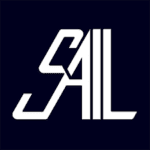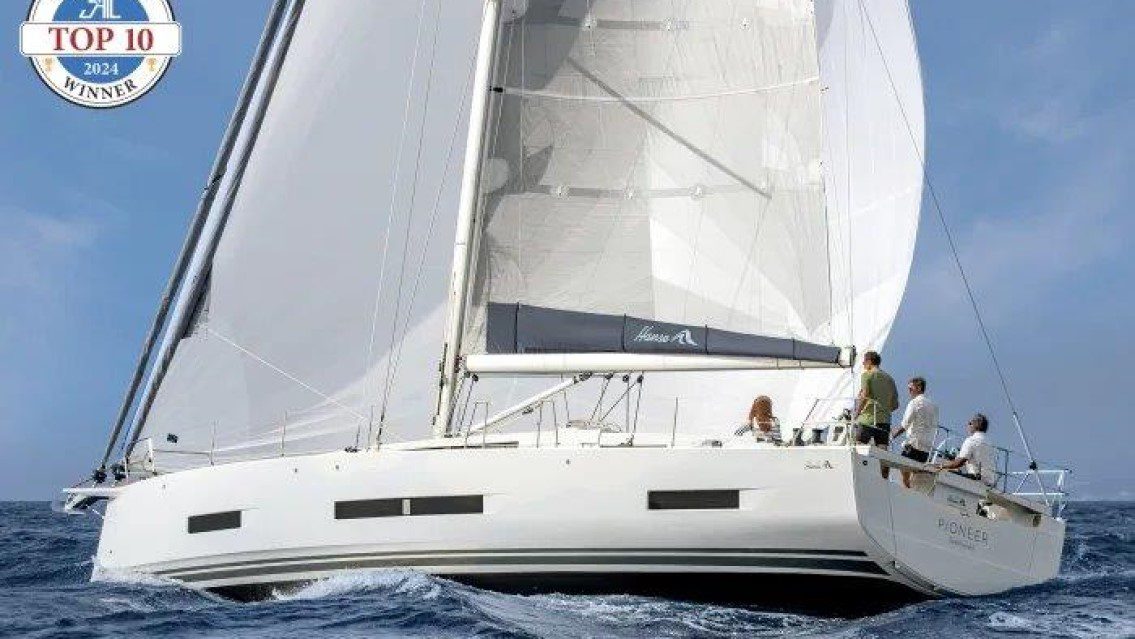Easy on the eyes and fun under sail, the Hanse 510 is more of a very good thing.

WENDY MITMAN CLARKE SAIL EDITOR-IN-CHIEF
January 18 ,2024
You never quite know what’s going to happen on a test sail; often, these boats are fresh off the presses, so to speak, still being set up when we’re invited along. So, it wasn’t overly surprising when our plan to unfurl the genoa on the new Hanse 510 came to an abrupt halt when we saw that the clew had been tied off around the furled sail—too far up to free it from the deck.
Solving this little problem was instructive. Once our test boat’s rep rigged a quick bosun’s chair and attached it to the gennaker halyard, it was a simple matter for me, steering off the wind under the main in about 12 knots true, to hoist him gently via the electric winch by the helm. He made quick work of the tie, returned to the deck, and within minutes we were romping off across the Chesapeake Bay, making an easy 7 to 8 knots of speed in 9 to 10 knots of true wind at apparent wind angles (AWA) of 65 to 70 degrees.
Fifty-two feet LOA can be a big boat for a couple of people to sail, and it would have been easy for that maneuver to be more difficult than it was. Which says something about the mission of this bigger sister to the highly successful Hanse 460—fast, comfortable cruising, easy sailing, and in this case, more than a little bit of luxury.
Hanse returned to Berret-Racoupeau, who also designed the 460 (a Top 10 Best Boats 2023 winner), to create the 510, and the result can leave you lingering over the lines. Starting with an aggressive, wave-piercing reverse bow, the relatively flat sheer and low deckhouse give this boat a fast, agreeably sharkish look even sitting still, despite the beam carried forward. A hard chine starts right at the bow—ostensibly helping achieve drier sailing—and carries but softens aft, making for a narrower boat on the waterline and less wetted surface below. An L-shaped, cast-iron keel has standard draft of 8 feet, while a shoal keel comes in at 6 feet 6 inches.
This helps translate into a slippery hull, as we saw on our test sail off Annapolis last fall. Our boat had a vertically battened Quantum mainsail on a deck-stepped, two-spreader rig with Quantum self-tacking jib and genoa on furlers in a Solent configuration. Tack for a gennaker was on the integral bowsprit. Under the full main, easily deployed via electric winch, and 570-square-foot jib we made 6.2 knots in about 10 knots true at 78 AWA, then quickly accelerated to over 8 knots in a 13-knot puff—pretty quick for a relatively small headsail.
Later as the wind diminished, we turned upwind toward Annapolis and in true wind of about 7.5 knots made 4.5 boatspeed at 44 AWA, not the sharpest pointing ever, and I would have been interested to see if she could have sailed higher in a little more breeze. While managing the self-tacking jib was an absolute breeze, I would have liked a bit more upwind horsepower; switching to the genoa gave us more speed, but not a great boost in pointing.

The control center in the salon island is a clever way to manage ship functions.
Photo courtesy Wendy Mitman Clarke
Off the wind with the genoa deployed, the sailing was just plain lovely and fingertip fun from the Carbonautica wheels on Jefa pedestals. The boat was responsive, accelerated quickly, and felt well balanced, and on a sparkling day with the bow pointed south, it wasn’t long before we were all joking about how easy it would be to keep on going until we made it to the big blue.
Moving around this big cockpit was a pleasure. Our test boat came with the windscreen and hardtop with a canvas panel in the middle that opened with an easy push forward. A connector between the hardtop and windscreen would fully enclose the forward end of the cockpit. The boat is available without the hardtop, but I’m not sure why you’d make that choice; with 7 feet of headroom, it provides full sun protection, great visibility, and in one option holds 1,260 watts of integral solar panels.
The forward portion of the cockpit is dedicated to entertaining and lounging, with L-shaped settees on each side, each with its own table but plenty of room between to provide clear access fore and aft. (Just forward of these tables under the floor is the life raft storage compartment.) Storage under these seats isn’t terribly deep but it’s enough for fenders, lines, and the like. Kudos for the sturdy handholds on both tables; too often, big lounge spaces come without anything to grab but your cocktail, but Hanse has maintained practical ergonomics throughout this cockpit, and that’s just one example.

Displays on the helm’s sides provide the helmsperson all the pertinent info while steering seated outboard.
Photo by Wendy Mitman Clarke
Another is the well-placed small step between the helms aft and the seats just forward. My hand automatically grabbed the hardtop’s stout vertical support here to make the single step up and out to the side deck, and it was a very safe feeling—how many boats have you had to clamber for the side deck without a thing to grab but air? All very well in flat water, not so great in any kind of seaway.
All lines lead under deck and aft emerging through a bank of clutches and back to the two, well-spaced winches on each side just ahead of the helms. Tails go into a bag under the step and another catchment under the outboard helm seat. These areas got pretty busy with line tails, and while I’m admittedly fussy about line spaghetti, there’s not a lot of room to clear stuff here, so it would bear watching.
Aft of the helms, the split backstay can have either a manual or hydraulic adjustment. To keep the cockpit clear, the mainsheet is led through two blocks just ahead of the windshield with controls led aft.
Controls on the helms are configured so that even when on the starboard helm you can operate the port electric winches; engine controls and throttle are on the starboard helm, so no bending over or crouching to reach for the power. Each helm has a handhold, up to 12-inch B&G chart plotters, compass, and the usual controls, but the really thoughtful detail was on each helm’s outboard side. Here, B&G displays and autopilot controls let the helmsperson easily sit to the side—where so many of us like to steer from—and still have all the needed information right there.

Carrying the chine all the way forward allows for a voluminous, luxurious master cabin. This cabin also can be split, making a four-cabin layout.
Photo courtesy of Hanse Yachts
Both helm seats lift on hinges to provide access to the drop-down transom, where you’ll find a massive garage that can hold a fully inflated 2.7-meter (just under 9 feet) dinghy, as well as access to the steering quadrant and cables. Hanse has developed two interesting features for this platform: a stair that automatically opens the platform and holds it in position, and a small crane to lift and dunk the dinghy—what the builder calls the Smart Tender System. Our test boat was standard in this regard, with the platform lowered via line and a telescoping folding ladder. Retractable, telescoping davits handled dinghy management.
Moving forward on the Flexiteek side decks was simple, with cabintop grabrails and outboard mounted shrouds that left the path wide open. The foredeck and cabintop were clear with unimpeded area for lounging. All the way forward, a hatch provided access to a cavernous sail locker with ladder access; this can be converted to a snug crew cabin. Immediately forward is the windlass and anchor locker.
Going below, five wide, secure steps lead to the salon, where the first thing you notice is the sheer space and height. At 5 feet 4 inches tall, I could just touch the overhead. The other immediate feature is the island between the dining area to port and the linear galley to starboard. With a handrail along its length—and solidly fastened to the sole—this island provides good support for moving fore and aft.
Its most interesting feature, though, is the control center accessed by lifting the lid on the galley-facing side. Here, we found the VHF, sound system, AC and DC distribution panels, and other items you’d commonly find in a nav station. It’s a clever way to manage ship’s functions, and the opposite side, facing the dining space (which also converts to a lounging area with the table lowered), holds a hideaway flat screen.
A word about configurations: Hanse provides immense flexibility in layouts and multiple choices even in specific sections of the boat such as the galley and owner’s cabin. Our test boat was the standard layout, with two big aft cabins sharing a head aft of the dinette and a luxurious owner’s cabin forward with en suite head. But layout options include adding a third head, a nav station that can double as a home office space, a crew cabin in that forwardmost compartment, and even splitting the forecabin for a four-cabin layout—with a variety of bunk/bed combos here as well.
No matter which you choose, 14 opening hatches and at least eight opening portlights or windows flood the boat with light and air. Every cabin has at least two opening windows or hatches for ventilation. Granted, these boats come with air conditioning, but it’s refreshing (no pun intended) to see a builder thinking about fresh air as equally valuable to comfort and energy efficiency afloat.
Full and easy access to our test boat’s Yanmar 110 engine and Fischer Panda 10000i genset was thanks to the lifting stairs and panels in each aft cabin, with the start battery front and center on a platform over the engine. That Yanmar and folding prop on a saildrive gave us 7.8 knots of speed at 2,100 rpm in flat water.
The electrical distribution system was behind the port dining settee with house batteries and a 3,000-watt Mastervolt inverter under the settee. The standard boat comes with two 160-amp hour Mastervolt AGM batteries and one 90-amp hour engine start battery; our boat had the upgrade to four house batteries, providing 640 amp hours. The windlass and optional bow and stern thrusters are 24-volt. A cruising upgrade provides six Lifos 105Ah Li-ion batteries.
Through hulls and other bilge access was via small compartments in the cabin sole; I was baffled why these didn’t have latches or any obvious way to pop them open. Otherwise, mechanicals were neat and showed good attention to detail. According to the builder’s spec sheet, hull and deck are cored with balsa and laminated with vinylester, making the boat light and strong.
Hanse has sold more than 200 of this boat’s little sister, the 460 that was launched in 2021. That’s a hard act to follow, but there’s no doubt this 510 will appeal to sailors who want a lot more of a good thing.
LOA 52’5” (with bowsprit) LWL 47’7”
Beam 16’1”
Draft 6’6” shoal; 8’ L-keel;
Air Draft 77’3”
Displacement 37,346 lbs shoal; 36,464 lbs L-keel
Ballast 10,494 lbs shoal; 9,612 L-keel
Sail Area 1,350 sq ft upwind; 2,927 sq ft downwind
Power 80-hp Yanmar with saildrive standard (110-hp option)
Designer Berret-Racoupeau
Builder Hanse Yachts hanseyachtsag.com
Price Fully equipped U.S. East Coast $900,000



